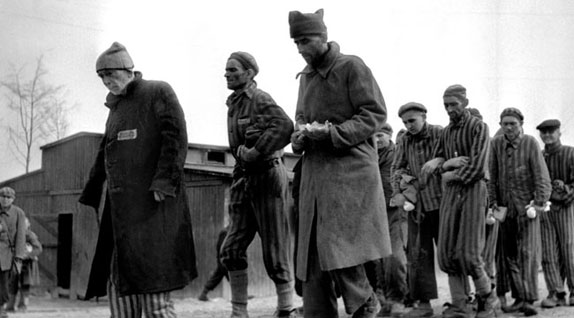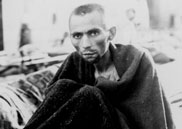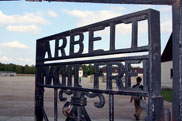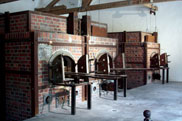 Eric Schwab/AFP/Getty Images
Eric Schwab/AFP/Getty Images
Article
A trip to the former Nazi concentration camp is a sobering reminder of how inhumanely man can treat fellow man. Will we forget the atrocities of decades past?
Learn the why behind the headlines.
Subscribe to the Real Truth for FREE news and analysis.
Subscribe NowHeadline: Savage Horror Of Dachau Will Never Be Forgotten
“DACHAU, Germany, May 1, 1945 (AP)—Every soldier, officer and war correspondent attached to the 42d (Rainbow) Division of the U.S. Seventh Army today had one word seared into his soul—‘Dachau.’
“It represents the last word in savagery, depravity, sadism and inhumanity. Here human beings were experimented on as though they were guinea pigs, were eliminated by slow starvation and their bodies burned wholesale in a gigantic crematory” (The Free Lance-Star).
On Sept. 2, 2009, my wife and I visited the memorial site of the Dachau Concentration Camp. It was one of the most sobering experiences of my life. The phrase quoted in one of the following news articles may have said it all: “a super-hell of horrors.”
Headline: Organized Nazi Brutality Found in Camps by Editors
May 6, 1945: “PARIS—(AP)—A commission of American newspaper editors reported yesterday it had reached the ‘inescapable’ conclusion after personal investigation that German political prison camps [including Dachau] were operated on a ‘master plan of calculated and organized brutality.’
“The 18 editors signing the report declared they had ‘convincing proof’ that ‘sadistic tortures too horrible and too perverted to be publicly described’ were embraced in the Nazi ‘system’ of operating these camps, and that ‘murder was a commonplace’ in the camps” (St. Petersburg Times).
The suffering that people experienced at Dachau, and so many camps like it, is nearly forgotten in the fast-paced, “live in the moment” 21st century, when people no longer make time to simply stop and think. Billions today were not alive to read the headlines and stories of 1945. So many have learned little about the millions exterminated during World War II—and those who do are often limited to a short, general segment on the Holocaust covered in a high school history class.
Headline: Foreign News: Dachau
May 7, 1945: “When all other German prison camps are forgotten the name of Dachau will still be infamous. It was the first concentration camp set up for Hitler, and its mere name was a whispered word of terror through all Germany from the earliest days of Nazi control.”
“Beside the highway into Dachau there runs a spur line off the Munich railroad. Here a soldier stopped us and said: ‘I think you better take a look at these box-cars.’ The cars were filled with dead men. Most of them were naked. On their bony, emaciated backs and rumps were whip marks. Most of the cars were open-top cars like American coal cars…
“Skeleton Stacks. We went on, and the great size of the establishment of Dachau began to open before us. Buildings and barracks spread on and on. Outside one building, half covered by a brown tarpaulin, was a stack about five feet high and about 20 feet wide of naked dead bodies, all of them emaciated.”
 National Archive
National Archive
“Each of these pitiful, happy, starved, hysterical men wanted to tell us his home country, his home city, and ask us news and beg for cigarets [sic]. The eyes of these men defy my powers of description. They are the eyes of men who have lived in a super-hell of horrors for many years, and are now driven half-crazy by the liberation they have prayed so hopelessly for” (Time).
A concentration camp such as Dachau represents the worst of humanity. Such sickening and repulsive savagery inflicted on one human being by another should never be forgotten. My personal journey into examining the past resulted in seeing undeniable evidence, which is seared into my memory, vividly and permanently. Permit this article, through words and photos, to do the same with you.
Historian George Santayana famously wrote, “Those who cannot remember the past are condemned to repeat it.” What has mankind learned?
First Impression
Nestled in the picturesque state of Bavaria, the former camp is just northeast of Dachau, a town that is about 12 miles (20 km) northwest of Munich. The contrast between the beautiful, clean countryside surrounding Munich—including the majestic Alps to the south, and medieval cities such as Salzburg and Augsburg to the east and to the west—could not be more striking. In the midst of this stunning area of the world lies a gray and somber place. A site where murder was commonplace, inhumane experiments the norm and suffering redefined.
Before arriving at the former concentration camp, our drive was like any other through the suburbs of a larger European city: traffic, construction, stoplights, gas stations, grocery stores, industry and suburbs. As we approached, we did not know how close we were. But within just a few seconds, the camp came into view. Missing the turn into the parking lot, we drove past the length of the prisoner camp, just outside its walls.
I will never forget the feeling I had as we reached the memorial site. Craning our necks to the left, the guard towers loomed over the seemingly impenetrable wall, the very sight of them almost inducing fear. Knowing their purpose suddenly made them seem more intimidating than the largest skyscraper. In a few seconds, the emotions of personal accounts I had previously read flooded up inside, resulting in a sickening feeling in the pit of my stomach.
Welcome to Dachau.
Hundreds of Thousands Imprisoned—Tens of Thousands Dead
After picking up a map and a self-guided audio guide, we proceeded toward the camp’s entrance. Here we found the “Jourhaus,” the prisoner entry station, with its wrought iron gate—the same gate where tens of thousands had entered, many en route to their deaths.
 The Real Truth
The Real Truth
The German phrase “ARBEIT MACHT FREI” was on the gate, words placed on many of the entrances to Nazi concentration and work camps. The phrase translates into “WORK SETS YOU FREE.” One could not help but think of the condescension dripping from those words directed toward the masses who lost their lives in Dachau—who walked through and read those very words, but who experienced the opposite of freedom, no matter the “work” performed.
Dachau opened its doors in March 1933, soon after Adolf Hitler came to power. It was the first concentration camp to be created under the auspices of a “work” camp. The compound began as a place to hold political prisoners, those who opposed the Nazi party. It was designed and established by Heinrich Himmler, chief of the Munich police at the time. Himmler became one of the most powerful men in Nazi Germany, and was in part responsible for the deaths of millions. He became Hitler’s head of the SS and the Gestapo, and one of the masterminds behind the concentration camp system. Dachau was the longest-running camp under the Nazi regime, a model for others built through the war.
Approximately 200,000 people from 34 nations were imprisoned in Dachau, and over 30,000 lost their lives there. The exact number will never be known because many deaths were undocumented. Unlike Sobibor, Auschwitz and Treblinka, Dachau was not an extermination camp; rather, it was a work camp, and therefore (relatively speaking) experienced fewer casualties.
However, since it was one of the first camps liberated by Allied forces, Dachau provided many of the initial accounts of Nazi atrocities. As a result, its horrors have been forever etched into the memories and consciences of many.
The camp’s size was small, considering the number of prisoners it ultimately held, initially built to handle perhaps a few thousand at a time. (The overall camp was much larger in 1945 due to other wartime functions it served; today, only the prisoner section remains open.) The memorial site showed the walls and prison grounds that would have been the home for inmates, some for years. Put in perspective, it probably was not much larger than the size of an American superstore and its parking lot.
As the war raged, overcrowding became the norm, and some 2,000 people were often crowded into a barrack designed to house 200. In November 1944, typhus broke out because of these conditions, killing thousands.
Liberation
On April 29, 1945, two U.S. units liberated 32,000 Dachau prisoners. Here are some excerpts from the internal report written by James W. Creasman, who was part of the 42d Rainbow Division. (The report was obtained by another soldier in the division.) The descriptive language could not be more chilling, and will likely bring tears to readers’ eyes:
“Dachau is no longer a name of terror for hunted men. 32,000 of them have been freed by the 42d Rainbow Division. The crimes done behind the walls of this worst of Nazi concentration camps now live only to haunt the memories of the Rainbowmen who tore open its gates and first saw its misery, and to accuse its SS keepers of one of the worst crimes in all history.”
“But no human imagination fed with the most fantastic of the tales that have leaked out from the earliest and most notorious of all Nazi concentration camps, could have been prepared for what they did see there.”
“Seasoned as they were by long acquaintanceship with stark reality, those trained observers gazed at freight cars full of piled cadavers no more than bones covered with skin and they could not believe what they saw with their own eyes.
“Riflemen accustomed to witnessing death had no stomach for rooms stacked almost ceiling-high with tangled human bodies adjoining the cremation furnaces, looking like some maniac’s woodpile.
“And when an officer pressed thru mobs of the forgotten men of all nations inside the electric barbed wire enclosure and entered a room where lay the dying survivors of the horror train, he wept unashamedly as limp ghosts under filthy blankets, lying in human excrement, tried to salute him with broom-stick arms, falling back in deathly stupor from which most would never rouse.
“Ten days before the arrival of the Rainbow Division fifty carloads of prisoners arrived at Dachau from the Buchenwald concentration camp in a starving condition after 27 days without food. When Buchenwald was threatened by advancing American troops the Nazi hurriedly crowded about 4,000 of their prisoners into the open flatcars unfit even for cattle. 27 days later—days of exposure to freezing weather without anything to eat, a trainload of human suffering arrived at Dachau only to be left to die in the railyard leading in to this extermination camp.
“In these stinking cars were soon the bodies of those prisoners too weak even to get out. A few tried, and they made a bloody heap in the door of one of the cars. They had been machine gunned by the SS. A little girl was in that car.
“In another car, sitting on the bodies of his comrades, his face contorted with pain frozen by death, was the body of one who completed the amputation of his gangrenous leg with his own hands and covered the stump with paper. Underneath was one with a crushed skull. ‘He’s better off now’ was the comment of one newsman. Close by was one who had been beaten until his entrails protruded from his back.
“But most of them had simply died in the attitudes of absolute exhaustion that only starving men can assume. Curled up with their faces resting in fingers, tipped with blue nails. With naked buttocks angling up to pivot on a skeletal pelvis. Or twisted over to show an abdomen stretched drum-tight against the spine with ribs making an overhanging bulge.
“Some of the cars had been emptied and the bodies carted to the crematory. In one room adjoining the furnace room on the left they were neatly stacked. The stripped corpses were very straight. But in the room on the right they were piled in complete disorder, still clothed.”
“It was incredible that such things could happen today, but there was the visible proof.”
“Those tortured dead can only be avenged when our world is aroused so much by what the 42d uncovered at Dachau and by what others have found at all the other Dachaus scattered throughout Germany, that never again will any party, any government, any people be allowed to mar the face of the earth with such inhumanity.”
Such powerful, sobering language. Person after person experienced some of the worst acts of atrocity known to man. The situation was so bad that over 2,000 died after liberation, unable to recover.
Personal Observations
As we walked through the prisoner camp, listening to the audio tour, each area of the memorial seemed to bring out a host of thoughts, observations and emotions.
As we approached one corner of the camp (near the entrance to the crematoria area), the guide noted the 10-meter-wide strip of grass encompassing the grounds before reaching the barbed wire, electrical fence—the “death strip.” If anyone so much as stepped on the lawn, SS guards from the guard towers would immediately mow them down with machine guns. Some, as the situation got increasingly desperate, would choose to throw themselves onto the death strip, putting themselves out of their misery.
 The Real Truth
The Real Truth
The crematorium, with its imposing smokestack, was perhaps the most chilling aspect of the entire memorial. One still stands today, built in 1942-43, called “Barrack X.” When the Americans liberated Dachau, it was here where they found bodies piled to the ceiling. To stand there made our visit so real—far beyond the academic. To walk up to the ovens where lifeless body after body was burned was beyond words. To know that people met their deaths by being hanged from the large hooks directly above the ovens brought a nauseating feeling.
The audio guide commented that one should respect the area, reminding listeners that they were standing in a cemetery. You could not disagree.
Another unsettling and distressing room was the gas chamber found within Barrack X. Disguised as a shower, it was a fairly dark room, with a hole on one end so those who conducted the gassing could see when the gas had done its job. Early reports concluded this was where mass killings occurred.
However, the guide explained there was no evidence that this particular gas chamber/shower was ever used for its intended purpose of mass extermination. Instead, it was used only on a limited, experimental basis. To walk through the chamber—knowing its sole purpose was the extinction of human life, and knowing that many others in camps across Germany and Poland were used for similar deadly atrocities—chilled me to the bone.
Then there were the appalling experiments. The audio tour reported an eyewitness account of these medical experiments: “SS doctors committed them on defenseless prisoners, abused them for their so-called medical experiments. Here prisoners were placed in ice cold water until they went completely numb, often for many hours, in order to determine the average time after which it no longer made sense to search the channel for shot down parachute jumpers. Experiments with bone transplants, phlegmon and hypothermia also were done in these barracks and led, after horrendous suffering, to an agonizing death.”
Connection to the Past
What will remain in my mind for the rest of my life was a man I observed in Dachau. He was an older gentleman. I saw him several times in different locations on the grounds. Since we were all giving our own self-guided tours, my wife and I occasionally crossed paths with him. I saw hundreds of people that day, but he stood out.
The first time I saw him, I noted something different. He was twice, probably three times the age of the average person there. He appeared to be in his 80s, possibly late-80s or early 90s, and he was alone. He walked slowly, but deliberately.
But it was his face that stood out the most, particularly the look in his eyes, which I will not forget. It was evident he had some connection to all that occurred there. There was a depth to his solemnity that I did not see elsewhere. There was deep reverence in his face mixed with thoughtfulness and sadness that was beyond the simple, quiet respect that others who were there exhibited. His reflection seemed to be personal in a way that my wife’s or mine could not be.
By his physical age alone, I knew he would have greater appreciation and depth than the scores of high school aged children on field trips. But more than his age, I could see that there was some sort of history. For someone who did not experience WWII, did not live through it, this had a profound impact.
Many questions arose: Who was this man? What side was he on? Why is he visiting now? Is he coming to be at peace with his past? What did he experience during the war? What suffering? What horror? Evil? Inhumanity?
Seemingly, the Second World War changed this man forever. And, in a small way, observing him changed me.
Never Again…?
In one area of the camp there was a large plaque. In several different languages, it stated, “Never Again.”
Another inscription read, “May the example of those who were exterminated here between 1933 and 1945 because they resisted Nazism help to unite the living for the defense of peace and freedom and in respect for their fellow men.”
Yet so many have already forgotten what occurred in places like Dachau. Perhaps worse, many more never fully learned it in the first place. Even more tragic, some—even leaders of nations—deny the Holocaust ever occurred, with growing numbers believing them.
For most living in the 21st century, 65 years ago may as well be four centuries ago, just one more historical factoid to be academically memorized for the next exam. In some regards, it’s hard to believe it until you are standing on the same earth where blood was spilled, where thousands lost their lives.
How could those who can barely imagine such horrors believe that it could happen again?
If man would only repent, turn to his Creator and obey Him, then horrors such as this would not happen. It starts with repentance—in other words, turning from disobedience and beginning to adhere to God’s laws.
If individuals and nations do not turn to God, then atrocities such as these (the “killing fields” of Cambodia, the massacres in Rwanda) will occur again.
In fact, prophecy reveals this will happen. Your Bible foretells a coming great captivity on the modern descendants of ancient Israel, far worse than what occurred in WWII.
Headlines from 1945 will pale in comparison to the ones in the near future: “Concentration Camp System Revived” — “Mass Deportation into Slave Camps” — “War Machine Fueled by Captives” — “Millions Exterminated.”
America and Britain in Prophecy, written by David C. Pack, explains the horrors knocking on the doors of unsuspecting nations. For those who will heed God’s warning, there is a way of escape.
More on Related Topics:
- Germany’s Economy Is Struggling. Here Are 5 Reasons Why
- France Has a New Government, Again. Politics and Crushing Debt Complicate Next Steps
- German Chancellor Loses Confidence Vote, Setting Up an Early Election in February
- French Government Felled in No-confidence Vote, Deepening Political Crisis
- What Does President Biden’s Decision to Allow Ukraine to Use Longer-range U.S. Weapons Mean for the War?



